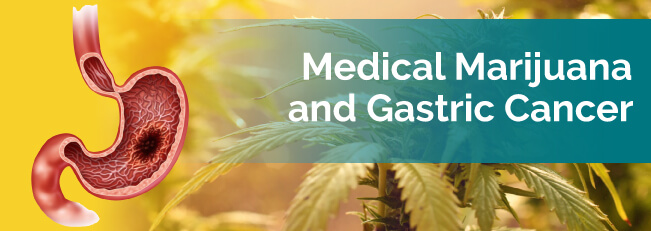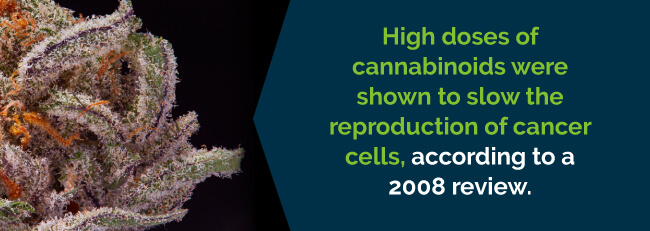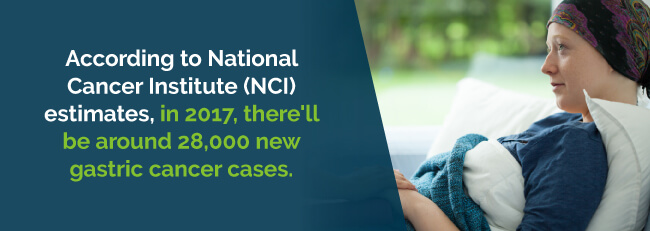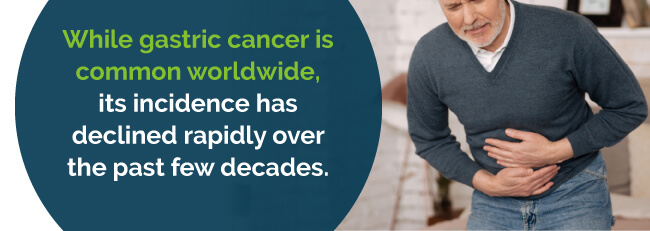
When it comes to medical cannabis for patients with cancer, the benefits are clear — reduced pain, increased appetite, helping with depression and fighting nausea and vomiting. Patients using medical marijuana for gastric cancer can realize all these benefits. Even though its anticarcinogenic effects are still being studied, ongoing research continues to point out patients claiming medical weed a miracle herb.
The gastrointestinal or GI tract includes the mouth, esophagus, stomach, small intestine and large intestine. It is here in the GI tract where digestion of food takes place. The stomach collects food and uses enzymes to break down partially digested food into usable nutrients. The stomach has three layers of tissue: the innermost (mucosal layer), middle (the muscularis layer) and the outermost (serosal layer). Sometimes the cells of the inner layer begin to grow rapidly and without order. When this occurs, cancer can develop. Cancer of the stomach is called gastric cancer. Gastric cancers can spread to the other layers of the stomach and to nearby lymph nodes. In the early stages of gastric cancer, symptoms can include indigestion, stomach pain, heartburn and loss of appetite. As the cancer progresses, symptoms progress to blood in the stool, vomiting, weight loss and the collection of fluid in the abdomen called ascites. Treatment and prognosis of gastric cancer depends on the stage at which the cancer is diagnosed. Stages of gastric cancer refer to the number of stomach layers affected by the cancer and the number of nearby lymph nodes where cancer cells are also present. Stage zero: Cancer is just beginning to affect the innermost mucosal lining of the stomach. Stage one: Cancer has begun to penetrate toward outer layers of the stomach or may have spread to nearby lymph nodes. Stage two: Cancer has spread further through layers of the stomach; more distant lymph nodes may be involved. Stage three: Cancer has spread through all layers of the stomach or is affecting more distant lymph nodes. Stage four: Cancer has spread to nearby tissues and organs or is spread to more distant areas of the body through the lymphatic symptoms. Treatment options include: gastrectomy, the surgical removal of part or all of the stomach, other options may include chemotherapy, radiation or any combination of these three therapies. Your doctor is the best source of information regarding treatment for your condition. It is important to discuss with your doctor which therapy, if any, is most appropriate for you. Learn more below about how medical marijuana can help treat gastric cancer.
There is now data materializing suggesting marijuana has compounds helpful in gastric cancer.
Tumor cells are continually growing and dividing, which is one reason they become malignant. Eventually, they reproduce to the point where they disrupt your essential bodily functions. Lab models have shown cannabinoids like CBD and THC stop this reproduction. In fact, high doses of cannabinoids were shown to slow the reproduction of cancer cells, according to a 2008 review. Cannabis at high doses increases the activation of cannabinoid receptors.
Find A Doctor Find A Dispensary

In another study, Korean researchers found the synthetic version of the THC cannabinoid, WIN 55,212-2, is antineoplastic, meaning it can hinder and prevent the development and growth of cancerous gastric cells.
In another 2009 study, THC killed cancer cells by causing them to self-digest and die.
Whether cannabis and gastric cancer treatment can reduce tumors or eliminate them, there are several ways cannabis may help relieve your stomach cancer symptoms. Marijuana pharmaceuticals are already an approved treatment in many states for nausea and vomiting occurring with cancer and its treatment.
A trial with 116 patients who used THC showed this cannabinoid effectively reduced chemo-related nausea and vomiting. In this trial, the THC was far more efficient than a placebo.
More research shows positive benefits of medical cannabis for gastric cancer in treating pain. In fact, American Cancer Society research even found vaporized medical pot effectively reduces cancer and chemo-related pain.

Marijuana for gastric cancer can help treat:
The best marijuana and gastric cancer strains have multiple cancer symptom-fighting properties. Therefore, if you or someone you love is battling cancer and its debilitating symptoms, below is a list of strains specific to target the symptoms you may be experiencing.
While there are more strains out there to tackle other symptoms of cancer and its treatments, the ones below are the most common.
You’ll want to experiment with various strains to find the one or ones that work best for you. It may take a period of trial and error, but the relief you will experience will be well worth it.
Multiple methods are available for using marijuana for gastric cancer.
Many patients like using cannabis oil daily for their cancer-related symptoms. Cannabis oil is a highly concentrated extract. It comes by various names, such as Rick Simpson Oil, Phoenix Tears, and Black Oil. Patients who use the oil say it takes around 60 grams/ml of the oil to affect cancer. They consume these 60 grams in 90-day cycles. When first starting off with this cannabis oil treatment, patients take smaller doses at first and slowly work up to a gram of oil daily in their 90-day period.
Medical cannabis tea for gastric cancer isn’t the most popular method, but many patients swear by it. Tea is high in phytochemicals, antioxidants and theanine, making it the perfect body booster. Adding THC to the tea produces a calming and soothing effect.
Tinctures are another method patients use when they wish to avoid medical weed’s psychoactive effects. Tinctures are concentrated forms of cannabis mixed with a type of alcohol solution.
You can affix transdermal patches laced with medical cannabis to your skin. They’re similar to nicotine patches, but use medical marijuana instead.
You can also use cannabis topically. It’s an easy way to get your marijuana and gastric cancer treatment without having to consume it orally. Physicians often suggest this method for children and older people who are not comfortable with consuming marijuana orally.
With suppositories, your bloodstream absorbs the maximum amount of CBD, THC and other cannabinoids. Once you insert the suppositories into your rectum, it takes around an hour to begin noticing its effects — however, once they begin, the effects last a long time. Medical marijuana suppositories are helpful for people who are severely nauseated and have difficulties taking other forms of cannabis, such as edibles.
Our MarijuanaDoctors.com website has abundant resources on medical cannabis and your health. Check out these helpful pages.
Read about marijuana news on our blog: We regularly update our blog with relevant information and news about the growing medical marijuana industry.
Find A Doctor Find A Dispensary
Gastric cancer, more commonly known as stomach cancer, can be characterized by cancer cell growth within your stomach’s lining. It can be challenging to diagnose gastric cancer, since many individuals don’t show signs or symptoms in their early stages.
According to National Cancer Institute (NCI) estimates, in 2017, there’ll be around 28,000 new gastric cancer cases. NCI also reports 1.7 percent of new cancer cases in the U.S. are stomach cancer.

Gastric cancer is a relatively rare form of cancer compared to other types. But because you usually don’t show symptoms of the disease in early stages, it’s one of the most dangerous types of cancers. Doctors may not detect it until after it’s spread to other areas of your body, thereby making it difficult to treat.
Scientists are unsure of the exact way in which cancer cells begin growing in a patient’s stomach. However, they are aware of what can raise a person’s risk for this disease. Researchers believe a significant cause of gastric cancer is an infection caused by H. pylori bacteria.
Other factors that seem to play a role in raising the risk include:
While gastric cancer is a complicated disease to diagnose and treat, it’s still essential to know all you can about it and the things you can do to deal with it, including how medical marijuana can help.
As early as 3000 BCE, papyri manuscripts and hieroglyphics from ancient Egypt defined gastric cancer. Data collected from 1760 through 1839 in Verona, Italy, represent the first extensive statistical analysis of the incidence and mortality rate of cancer, showing it as a common and lethal type of cancer. It remains one of the most substantial malignant diseases, having significant ethnic, socioeconomic and geographical differences in distribution.

While gastric cancer is common worldwide, its incidence has declined rapidly over the past few decades. This decline could be partly due to the recognition of specific risk factors, like environmental and dietary risks and the H. pylori bacterial infection, and people making lifestyle and other changes to reduce their possibility of developing the disease.
Symptoms of stomach and gastric cancer may include:
If you’re experiencing these or any other symptoms that cause you concern, set up an appointment with your physician. Other conditions could be causing these symptoms.

Types of stomach cancer include:
There are other cancer types, such as small-cell carcinoma, squamous cell carcinoma and leiomyosarcoma, beginning in your stomach, but they’re rare.
Several factors determine your physical health when you have stomach cancer, including its stage, your general health and the dose and length of treatment. Physical side effects can sometimes last after you’ve finished treatment.
Because many individuals receiving treatment may have an increased risk of experiencing long-term effects, evaluation and treatment of late effects is an integral part of your cancer and survivorship care.
Gastric cancer treatments like radiation therapy and chemotherapy may lead to long-term effects like:
You may experience mental effects, as well.
When you survive cancer, you may experience negative emotions like:
Post-traumatic stress disorder (PTSD) is another effect you or your loved ones may also experience. A type of anxiety disorder, PTSD develops after you have just experienced a frightening or life-threatening event, such as receiving a diagnosis of cancer and going through its treatment.
U.S. estimates for the year 2017 by the American Cancer Society are:
The best-case scenario with gastric cancer would be to prevent its occurrence altogether.
The cause of gastric cancer isn’t clear, and therefore, it’s difficult to know how to prevent it. However, there are steps you can take to help reduce your risk of stomach cancer. These measures include making small, everyday changes to your life, including:
Your physician can help you determine your risk for stomach cancer, and may perform periodic endoscopies to check for signs of gastric cancer.
A variety of treatments can help fight gastric cancer. The type of treatment you and your physician decide on depends on several factors, including the stage of your cancer, how long you’ve had it and if and how much it’s spread throughout your body.
If your surgeon finds cancer cells, they may remove a portion of your stomach and/or nearby tissues. Surgery eliminates the tumor and attempts to keep cancer from spreading into other areas of your body. If you have a more advanced stage of gastric cancer, your surgeon may have to remove your entire stomach.
In some cases, a tumor may keep the food you eat from moving into and out of your stomach. If this is your case, your surgeon may need to put in a stent to keep pathways open.
Once you recover from surgery, you may experience some side effects such as heartburn, nausea, diarrhea and abdominal pain, especially after you eat. These side effects occur because after your surgeon removes your stomach, your food will enter your intestines too rapidly after you eat.
Chemo medications keep your cancer cells from growing or kill them altogether. You’ll either take the drugs orally or through an IV. This treatment typically takes a few weeks. The medications often cause side effects your physician will help you alleviate during and after treatment.
Chemo can cause many side effects, including:
With radiation, your doctor uses high-energy particles or waves to shrink tumors and kill cancer cells. They may need the help of X-ray devices to beam the radiation at the location of your tumor.
You’ll experience any side effects of radiation within several weeks of beginning your treatment. The side effects will likely go away a couple of months after you finish treatment. Side effects may include skin changes and fatigue. You may experience specific site side effects, as well. For instance, you may experience mouth problems or hair loss if the radiation is directed in those areas.
Before surgery, your surgeon may use a combination of radiation and chemotherapy to shrink your tumor. There are side effects to this combination as well.
Both radiation and chemo cause nausea and vomiting. Persistent diarrhea and vomiting can dehydrate your body as you lose significant amounts of nutrients and water. You may lose your appetite because of feeling nauseous with treatment. You may also experience dry mouth, mouth sores or skin rash.
Targeted drugs are newer options to fight only your cancer cells. In this way, they are unlike radiation and chemotherapy, which kill your healthy cells as well as your cancer cells. There are fewer side effects with targeted therapies, too.
Some side effects you may experience include: